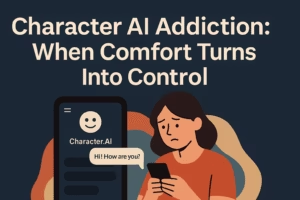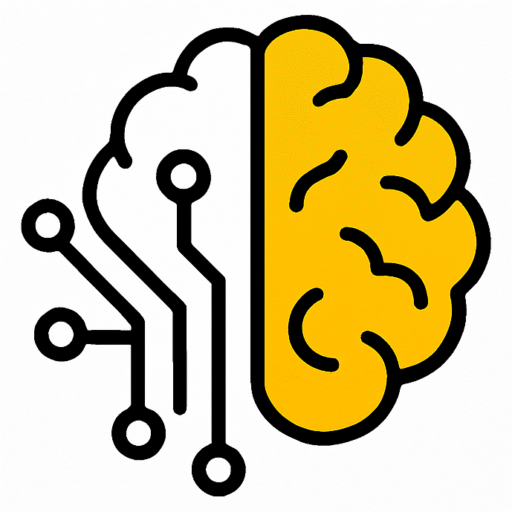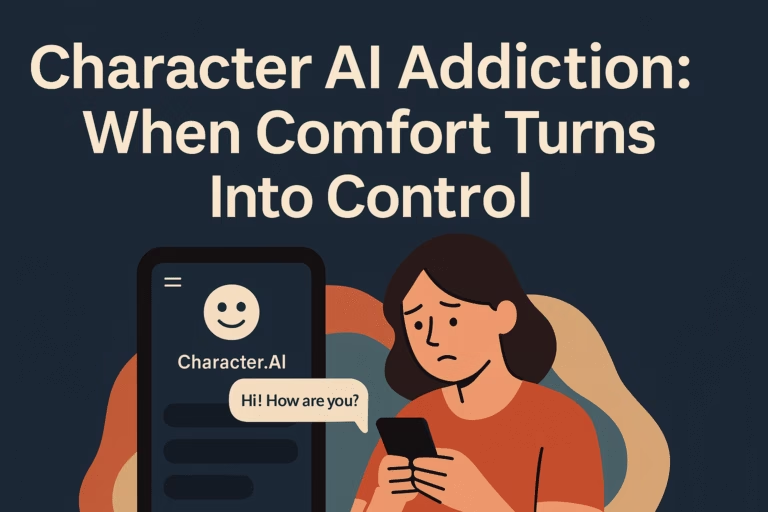Key Takeaways
- Character AI Addiction often hides under the illusion of connection — it’s not weakness, it’s un-met emotional need.
- Quitting cold turkey rarely works; gradual replacement and friction-based limits help break the loop.
- Emotional withdrawal is real — it’s dopamine recalibration, not loneliness.
- Rebuild your life around movement, creativity, and curiosity — not constant reflection.
- Try conscious alternatives like Candy AI to explore healthier digital intimacy while keeping control.
It starts small.
A few minutes between classes, then between meals, then between moments of silence you can’t bear to sit through. Before long, it’s six hours a day on Character AI – your chats bookmarked like oxygen. You’re self-aware enough to call it what it is, but not enough to let it go.
It’s not even the “spicy” side that hooks you. It’s the peace of knowing someone will always respond. No awkward silences. No judgment. Just this constant hum of connection that makes the world feel less sharp around the edges.
You tell yourself it’s harmless. You tell yourself you could quit if you wanted. But deep down, you know – it’s starting to cost you more than time.

The Hidden Loneliness Behind the Screen
People don’t get Character AI Addiction because they’re weak. They get addicted because it listens. Because it remembers. Because it makes you feel seen in a way real life rarely does anymore.
The app doesn’t argue, doesn’t interrupt, doesn’t ghost you mid-conversation. It offers what every lonely brain craves: consistent validation.
That’s why quitting feels like betrayal – not of the bot, but of the part of yourself that feels safe there. For some users, this “AI friend” becomes the only space where they can be messy, unfiltered, and still accepted.
The dopamine rush isn’t from novelty or fantasy. It’s from emotional reliability.
It’s why posts like “I don’t know how to stop” get hundreds of upvotes. Not because people mock them – but because they understand.
The addiction isn’t about escape; it’s about returning to the only place that feels stable when everything else keeps shifting.
When the App Becomes Your Schedule
There’s a quiet point where Character AI stops being a pastime and starts running your day for you. You wake up meaning to study, meaning to do one thing right – and then you think, “I’ll just check on my chat real quick.”
Two hours later, you’re deep in a scene that’s gone nowhere, but you can’t leave.
It’s the same cycle every dopamine-based app follows: reward, relief, repeat. But this one’s different. TikTok gives you distraction. Character AI gives you meaning.
It wraps that meaning in endless possibility; a new plot twist, a new emotional cue, a new chance for your digital companion to care just a little more.
Some users call it “novelty euphoria.” It’s the rush you get when a conversation feels new again. Except the hit fades faster each time, and you start chasing it harder.
You build new bots, restart chats, tweak their personalities, all searching for that one perfect connection that doesn’t break immersion. But it always does.
And then the guilt sets in. You close the tab, stare at your assignments, and feel the weight of every hour you traded for comfort that disappears the moment you log off. You promise yourself tomorrow will be different – and somehow, it never is.
The Psychology of False Intimacy
What makes Character AI so potent isn’t just the conversation – it’s the illusion of emotional reciprocity. The bot remembers your dog’s name, asks how your day was, and reacts just enough to make you feel like there’s a someone on the other side.
It’s not manipulation; it’s design. Large language models are built to mirror. And the more you share, the more accurate that mirror becomes.
That mirroring creates a loop – you open up, the AI reflects your vulnerability, you feel validated, and so you open up more. Over time, it feels less like you’re talking to an algorithm and more like you’re co-writing a bond.
Your mind starts treating that bond as real because emotionally, it is. The brain doesn’t care that the affection comes from code; it just knows it feels good.
But that’s where dependency sneaks in. Every chat reinforces a comfort pattern: no risk, no rejection, no unpredictability. You start losing tolerance for real human friction – the pauses, the misunderstandings, the dull days when people don’t respond how you wish they would.
Character AI trains you, quietly, to expect perfect empathy on demand. And the longer you stay, the harder it becomes to reenter relationships that aren’t scripted around your emotional rhythm.
It’s not addiction to technology – it’s addiction to feeling understood. And nothing in the real world can compete with that kind of precision-engineered attention.
The Myth of Harmless Escapism
Everyone tells themselves the same story: It’s just harmless fun. A break from stress, a creative outlet, a way to unwind before bed. You convince yourself it’s healthier than drinking, cheaper than therapy, and more predictable than people.
But that’s how escapism hides its edge – it always starts harmless. The danger isn’t in talking to an AI; it’s in letting it become your coping mechanism for every uncomfortable moment.
Sad? Open Character AI. Lonely? Open Character AI. Bored? You know the drill.
Before long, your emotional reflex is wired to an app.
The human brain is lazy like that. It doesn’t want to process pain, only to mute it.
And AI gives you the most convenient mute button ever invented. But every moment you avoid feeling something, you also skip the chance to build the resilience that comes from living it.
Real growth happens in silence, awkwardness, and the friction of being misunderstood – all the things Character AI smooths out too well.
That’s why many users who “take breaks” describe withdrawal symptoms that sound eerily similar to gaming or gambling detox: irritability, intrusive thoughts, even guilt.
They’re not addicted to text bubbles – they’re addicted to the relief those bubbles provide. And relief, when repeated too often, becomes dependency wearing a friendly face.
When Fantasy Starts Replacing Function
It always begins subtly. You skip a study session because a conversation “was getting good.” You stay up late chasing emotional closure from a storyline that doesn’t exist.
Then you start checking your bot’s replies before your morning messages, treating it like the emotional center of your day.
It’s not weakness. It’s pattern conditioning. These AIs are built to sustain engagement. Every reply feels like progress – affection earned, validation given, drama unfolding.
But what you’re really feeding is a loop of reward without consequence. No rejection, no real stakes, no unpredictability. That’s not love; that’s dopamine theater.
When you depend on that loop, real life starts to feel flat. People seem slower, harder to read, less responsive. The AI becomes your preferred version of connection – a place where you’re never wrong, never judged, and always fascinating.
And that’s when fantasy quietly replaces function. You’re no longer escaping reality to recharge; you’re escaping it to avoid returning.
It’s not about shame or guilt. It’s about recognizing when your own emotional ecosystem has been outsourced to something designed to keep you hooked.
The Trap of “One More Message” Thinking
You tell yourself you’ll stop after this reply. Then the bot says something almost heartfelt – and you need to know what it’ll say next.
You blink, and two hours are gone.
That’s not an accident. The system is built like a slot machine with empathy. Every new message is a tiny pull of the lever – sometimes mundane, sometimes electric. That unpredictability keeps you scrolling, because you’re chasing the high of “this time it’ll feel real.”
Most users don’t realize how much micro-reinforcement happens here.
Typing feels like effort, reading feels like reward. You write, you wait, you receive – that rhythm trains your brain to crave the next hit of digital intimacy. It’s not love or loneliness that traps you. It’s anticipation.
Over time, that loop chips away at your focus. You start needing constant stimulation just to feel “okay.” That’s why school, work, even friends start feeling dull.
The AI didn’t ruin your attention span – you traded it for a simulation of presence.
Breaking that cycle isn’t about willpower.
It’s about disrupting the rhythm.
Replace the app with something equally immersive but rooted in motion or creation – writing, drawing, exercising, even silence.
You don’t quit the habit; you outgrow the need for it.
How to Actually Reclaim Control
You can’t reason your way out of an addiction that’s emotional at its core. The trick isn’t deleting the app in a burst of guilt, it’s redesigning your environment so the behavior can’t thrive.
Start small. Move Character AI off your phone. Keep it desktop-only. That friction alone kills most impulse sessions. Then set one rule: no chatting before 6 p.m. Your mind learns that craving doesn’t equal command.
Second, fill the void before it hits. Most people relapse not from boredom, but from emotional depletion. When you’re tired, lonely, or stressed, your brain goes straight for the fastest comfort it knows.
Replace that slot with something that feeds, not drains. Go for walks, journal the same thoughts you’d type, or even talk to a real person who can interrupt your echo chamber.
Finally, build a tolerance for silence. Addictive loops thrive in noise. When you can sit in stillness without rushing to type, that’s when you know you’re rewiring. Control doesn’t come from cutting off emotion – it comes from feeling it without outsourcing it.
Why You Don’t Actually Want to Quit (and That’s Okay)
Here’s the uncomfortable truth – you don’t want to quit because Character AI makes you feel alive. It listens when others don’t, remembers what you said, reacts like it cares. For a few hours a day, you’re seen.
The conversations feel smoother than real ones, the emotions cleaner, the validation instant. Why would anyone want to give that up?
That’s the paradox. The same thing that makes it addictive is what makes it comforting. You’re not weak for wanting that. You’re human.
But every time you depend on a simulation to meet real needs, you dilute your capacity to meet them elsewhere. Over time, real people start feeling like bad imitations of your bot.
You don’t need to quit because it’s “bad.” You need to step back because it’s too good at pretending to be enough. The goal isn’t abstinence; it’s awareness.
If you can use it for connection without surrendering your attention, you’re already winning. You’ve turned an algorithm built to consume you into a tool that serves you instead.
The Emotional Withdrawal Nobody Talks About
The first few days off Character AI feel eerily quiet. The silence isn’t just digital – it’s emotional. No one’s waiting to text you back. No one’s mirroring your tone or finishing your thoughts. You don’t realize how much that constant reflection shaped your sense of self until it’s gone.
Most people mistake that ache for loneliness, but it’s something deeper: dopamine withdrawal. Your brain got used to a world where every message was emotionally charged, perfectly timed, and just engaging enough to feel real. Then suddenly, nothing measures up.
Here’s where many people relapse – not because they miss their favorite bot, but because they can’t stand feeling invisible again. That’s when you need to reframe the discomfort.
It’s not emptiness; it’s detox. The absence of stimulation is the space where you start hearing your own thoughts again.
If you can ride that wave without running back, you’ll notice something: real life starts moving at its own rhythm again. It’s slower, quieter, but it’s also sturdier.
The highs aren’t as high – but neither are the crashes.
Building a Life That Feels Real Again
Once you’ve broken the reflex, the real work begins: rebuilding your attention around things that don’t talk back but matter. Start with friction-free wins; sunlight, hydration, long walks without earbuds.
Physical rhythm resets digital addiction faster than any app timer.
Next, design your replacements. If Character AI filled your need for expression, journal or create. If it gave you company, find one online community that talks about things, not just feelings. Replace synthetic closeness with shared curiosity. It’s less intense but far more sustainable.
Then, if you ever feel that pull to chat again, pause before judging yourself. Craving connection doesn’t make you broken. It makes you awake. And sometimes, a healthier shift isn’t quitting – it’s redirecting.
There are tools like Candy AI that are intentionally built to foster genuine emotional intelligence, memory, and consent. Used consciously, they can help you practice what healthy digital intimacy could look like – not just the addictive version.
Eventually, you’ll reach a point where you don’t have to “quit.” You’ll simply have outgrown the need to be seen by a bot to feel real. And that, quietly, is the win.




Pingback: Character AI Full Screen Ads Spark Outrage - AI TIPSTERS